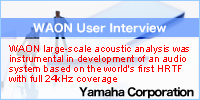WAON User Interview: Yamaha Corporation "Without WAON, the software enabling large-scale model analysis, and without our technology for feeding back the WAON analysis results into product development, this development would not have been possible." -WAON large-scale acoustic analysis was instrumental in development of an audio system based on the world's first(*1) HRTF with full 24kHz coverage-
Introduction
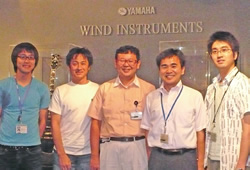
From left to right:
Y. Shiozawa, A. Miki, M. Katayama,
H. Onitsuka, T. Suenaga
| The interviewees |
|---|
|
Center for Advanced Sound Technologies Innovative Technology Division Senior Engineer Hirofumi Onitsuka Assistant Manager Akira Miki Tsukasa Suenaga Yasuo Shiozawa Technology Development Group2 Technology Development Department AV Products Division Assistant Manager Masaki Katayama |
For this report, we called on Yamaha Corporation. As a manufacturer of all kinds of musical instruments, the company continues to lead the market. Its high-end AV products, incorporating audio technology accumulated over the years, are also big hits with audio fans throughout the world.
Now comes the DVX-1000, released in March 2008 as the world's first 24kHz HRTF based home theater system. The development of this system represents the culmination of Yamaha's audio technology and acoustic simulation know-how. In this series of interviews, we talked with Yamaha people about the back-story of the development project, and about the use of the large-scale acoustic analysis software WAON in the project.
Interview Contents
First tell us about the work you do at Yamaha.
| Onitsuka: | I'm with the Center for Advanced Sound Technologies, where I work on developing basic technologies for analyzing and measuring acoustics and vibration, and on putting these technologies to practical use. My mission also includes human resources development. Besides acoustic analysis, I'm involved in evaluating physical properties including the coupling characteristics of sound and structure, fluids, magnetic fields and so on. |
| Miki: | I used to measure and design hall acoustics, until I joined the acoustic modeling group about a year ago. These days I spend most of my time using WAON and other CAE tools for troubleshooting and suggesting solutions, typically in response to requests from other departments that work with hall speakers. |
| Suenaga: | I've likewise been engaged in analysis-related work since last year. Before that I worked on signal processing, and developing models for DSP-based products, among other things. Right now I'm involved in both signal processing and acoustic analysis using tools like WAON. I also use MATLAB a lot. |
| Shiozawa: | I do research and development in element technologies. My work includes joint research with university labs, and vibro-acoustics analysis of musical instruments. |
| Katayama: |
I'm with the AV Products Division, where I work on
DSP application development. The applications
are used in AV amps for home theater as well as
system products. Starting out with the element
technologies developed in the Center for Advanced
Sound Technologies, we choose the applications
that best meet the needs of the consumer products
market, and then develop these into actual products. An example we're all familiar with is the DVX-1000 home theater system released in March [Figure 1]. It adopts Yamaha-original technology that Hirofumi Onitsuka and I labored on for 10 years. |
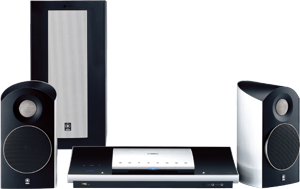 Figure 1. DVX-1000 *Received 5 star review from What Hi-Fi Sound and Vision (Haymarket Consumer Media Ltd) ( DVD Home Theater System DVX-1000 Website ) |
What can you tell us about the next-generation virtual surround technology adopted in the DVX-1000?
| Katayama: |
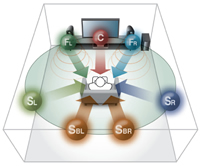 Figure 2. Schematic of next-generation virtual sound technology AIR SURROUND XTREME 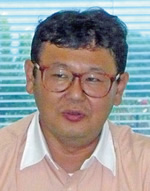 Masaki Katayama A home theater system applies the same principle, surrounding the viewer with speakers. A 5.1ch system, the most popular kind today, uses one front-center speaker, two front speakers (left and right), two surround speakers to the left and right of the viewer, and also a sub-woofer, for a total of six speakers. A more advanced 7.1ch system adds two speakers in the rear. Such a setup will not always be practical in the home, however. There may not be enough space, or maybe you don't want all those speaker cables in the way when doing housecleaning. So this development project started out by asking if we could somehow achieve a similar effect using virtual technology. With the DVX-1000, we succeeded in realizing sound equivalent to that of a 7.1ch high-end home theater system, using only two center-front speakers and a subwoofer [Figure 2]. That's something no one else in the world has accomplished besides Yamaha. |
Could you describe the course of the development and features of the product?
| Katayama: |
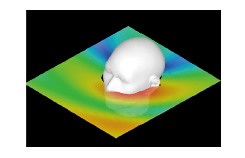 Spatial sound pressure distribution near head 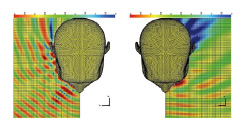 Spatial sound pressure distribution near ears 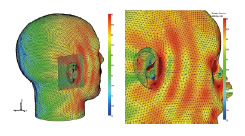 Sound pressure distribution on head surface Figure 3. Head-related transfer function (HRTF) calculation Methodology: WAON fast multi-pole boundary element method (FMBEM) With the DVX-1000, sound really seems to be coming from the rear. Even surround systems that actually have speakers in the rear can't always achieve this effect, so ordinarily it would be unthinkable in a virtual system. The key to creating such realistic sound is the accurate quantification of the HRTF (head-related transfer function), which represents how sound emanating from various directions arrives at the left and right eardrums. People point to two major issues with conventional virtual surround technology. The first is that the HRTF used for the analysis is based on a onesize- fits-all model of the head, with insufficient allowance made for individual differences in head shapes of listeners. So we ran simulations for lots of different head models [Figure 3]. On that basis we developed a new, highly universal head model, which in turn enabled us to obtain a next- generation HRTF, which means that all kinds of listeners can experience realistic sound localization - the direction from which sound arrives, and true depth perception. The important point here is that we used simulations, not actual measurements. For actual measurements, dummy heads are used for sound recording; but it wouldn't be practical to create dummy heads accounting for the many individual variations in head shape. Simulation, on the other hand, let us create a large number of head shapes, which could be analyzed immediately for calculating HRTF. That's why we were able to develop a head model that allowed us to calculate an HRTF applicable to just about everyone. We asked people from various countries to listen to virtual surround using this HRTF. They were all astounded to hear sound coming from behind them. Seeing their reaction convinced us that this model is one we could use. It took us three years from the time we began the development using simulations, but at last we succeeded. A second issue is that the HRTF used up to now could not cover the full 20kHz spectrum audible to the human ear. The actual range of frequencies that people can hear as "sound" is said to be a bit over 15kHz, so you might wonder why it's necessary to go to that extreme. Realizing virtual surround, however, requires performing calculations with sound data, and there is a big difference in the results when data used for the calculations is all guaranteed over the necessary range and when the full range is not guaranteed. When calculations are made using non-guaranteed data, some kind of human intervention takes place in the nonguaranteed range. We believe that this intervention is what causes the sound quality deterioration typical of virtual surround, such as live instruments not sounding convincingly live, or the human voice having a mechanical sound. Thanks to WAON, however, we were able to obtain precise data guaranteed over the full range including high frequencies, so no intervention was necessary. As a result, we were able to reproduce sound fields with very high accuracy. The DVX-1000 features what is called a music mode, which truly makes you feel you are surrounded by live instruments. This is technology only Yamaha has, and it's winning high praise from customers. These achievements were the culmination of our many years of experience with acoustic technology and simulation know-how, but this alone would not have been enough. Without WAON, the software enabling large-scale model analysis, and without our technology for feeding back the WAON analysis results into product development, this development would not have been possible. Both these technologies together were what made this development happen. |
| Onitsuka: |
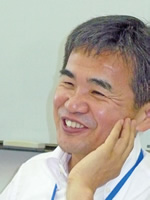 Hirofumi Onitsuka |
What plans do you have for the future?
| Katayama: | This is now the high-definition age, when people are demanding high image and sound quality. The standard for HD sampling data is 96kHz, so we'd like to build a system able to handle that much data. More than just listening, you'd be able to feel the sound directly. In the "surround" world, 96kHz will be necessary for conveying the atmospherics, the air that is outside the range of audible sound. This will be much more difficult than anything we've done up to now, but it will be well worth the effort. |
| Onitsuka: | Yamaha is a company that deals with sound in many different forms. Our needs for analysis arise with regard to a variety of topics, and in quite a few cases coupled analysis becomes necessary. If WAON had coupled analysis functions, it would fi nd wider use, I believe. I also think ANSYS is excellent for coupled analysis. If it could be combined with WAON, that would make possible coupled analysis in diverse fields, which would be useful for creating better products. |
Our structural-acoustic coupled analysis function was released in September 2008, so we hope you will make use of it. Do you have any other comments on WAON functions?
| Suenaga: |
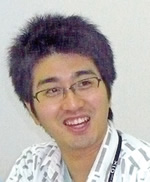 Tsukasa Suenaga |
| Onitsuka: | The kinds of sounds Yamaha deals with are mostly music, so we have to cover the whole range from lows to highs. That tends to result in large amounts of data to be processed. |
| Suenaga: | What struck me when I tried it out was how simple it is. There are products from outside of Japan with lots of functions, but sometimes with all those choices you can wind up in a dead-end. There's no such worry with WAON. |
| Onitsuka: | When we train CAE engineers in our company, the most important thing is getting off to a proper start. When a user looks at a software GUI or manuals and doesn't feel entirely comfortable with it right away, that generally means it's going to take longer to learn the software, and the desire to learn it will be diminished. With WAON, however, nearly everyone gets into it immediately. You feel like, Hey, this is something even I can do. This is really helpful from a teaching standpoint. Up to now, we've had to teach them how to do everything, from the basic details; whereas with WAON they can pretty much get started all by themselves, without having to be told how. |
| Miki: |
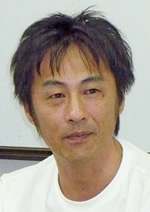 Akira Miki |
Our development goal from the start was to design the software for intuitive use, without having to read a manual. Even if we add more functionality to it, we'd like to make sure we don't sacrifi ce ease of use. Do you have any other requests you'd like to make?
| Onitsuka: | I would like to see a lot more plus-alpha features that no other competing products have, such as the ability to include in analyses the components that are left out in the case of the conventional wave equation model. It would also be useful if there were a simple way to compare experimental data and analytical data. Enhanced customization functions would be helpful as well. |
| Shiozawa: |
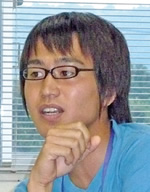 Yasuo Shiozawa |
| Onitsuka: | A more intuitively understandable way of displaying vector coeffi cient results would be nice, too. |
Thank you for sharing your views with us.
We intend to continue reflecting customer needs in our on-going development of WAON
features. What about Cybernet? Is there anything you would like us to do better?
| Onitsuka: | Cybernet technical support has been quite good, so I hope you keep this.
Lately I've been thinking Japan's vendors should just concentrate on doing what Japanese vendors do best. Internationalization is very important, but I don't want companies to forget their roots. Being "Japanese" means, for one thing, paying close attention to technology down to the finest details when building products. That applies also to software. Pour your heart into developing, thinking about things down to a level of detail that might even seem excessive in terms of the overall picture. That's how truly Japanese software and service come into being. This is also the reason I think Cybernet's support is so good. You take the time to look carefully and thoughtfully at our needs. Please continue in that vein, and continue providing products and services in the best traditions of a Japanese company. Together with end-product manufacturers like us, I hope that we can all contribute in creating excellent "made-in-Japan" products. |
We still have a long way to go, but I believe you are exactly right. We hope for your continued support as we try to put such ideals into practice. Our sincere appreciation to Hirofumi Onitsuka, Masaki Katayama, Akira Miki, Tsukasa Suenaga and Yasuo Shiozawa of Yamaha Corporation for taking time from their busy schedules to sit for this interview.
(Sept. 2008, Issued by CYBERNET SYSTEMS CO., LTD.)
(*1)At the time of March 6, 2008 Yamaha Corporation reserched.



